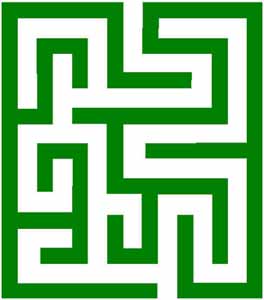
As with all things a Labyrinth is just another tool to create balance in brain chemistry. There are various styles and descriptions some of which may connect for you while others do not. Basically it's balancing right left brain chemistry, starting from the outside and working your way to a central point or the opposite. It is best to walk a labyrinth in nature but other surfaces will work as well especially when they're in a secret place such as a cathedral.
A labyrinth is an ancient symbol that relates to wholeness. It combines the imagery of the circle and the spiral into a meandering but purposeful path. It represents a journey to our own center and back again out into the world.
Labyrinths have long been used as meditation and prayer tools. A labyrinth is an archetype with which we can have a direct experience. Walking the labyrinth can be considered an initiation in which one awakens the knowledge encoded within their DNA.
A labyrinth contains non-verbal, implicate geometric and numerological prompts that create a multi-dimensional holographic field. These unseen patterns are referred to as sacred geometry. They allegedly reveal the presence of a cosmic order as they interface the world of material form and the subtler realms of higher consciousness.The contemporary resurgence of labyrinths in the west is stemming from our deeply rooted urge to honor again the Sacredness of All Life.
A labyrinth can be experienced as the birthing womb of the Great Goddess. Thus, the labyrinth experience is a potent practice of Self-Integration as it encapsulates the spiraling journey in and out of incarnation. On the journey in, towards the center, one cleanses the dirt from the road. On the journey out, one is born anew to consciously dwell in a human body, made holy by having got a taste of the Infinite Center.
In recent years, there has been a resurgence of interest in the labyrinth symbol, which has inspired a revival in labyrinth building, notably at Willen Park, Milton Keynes; Grace Cathedral, San Francisco; Tapton Park, Chesterfield; and the Labyrinthe de Harbor 16 in Montreal. Countless computer games depict mazes and labyrinths, e.g. the Lara Croft series. On bobsled, luge, and skeleton tracks, a labyrinth is where there are three to four curves in succession without a straight line in between any of the turns.

In modern imagery, the labyrinth is often confused with the maze, in which one may become lost. The myth of the labyrinth has in recent times transformed into a stage play by Ilinka Crvenkovska which explores notions of a man's ability to control his own fate. Theseus in an act of suicide is killed by the Minotaur, who is himself killed by the horrified townspeople.The Argentinian writer Jorge Luis Borges was entranced with the idea of the labyrinth, and used it extensively throughout his short stories. His modern literary use of the labyrinth has inspired a great many other authors in their own works (e.g. Umberto Eco's The Name of the Rose, Mark Z. Danielewski's House of Leaves).
The effects of walking the labyrinth vary from person to person and even with the same person on different occasions. Each time you move through the labyrinth it may be for a different reason. You may be seeking:
![]() balance or centering
balance or centering
![]() healing
healing
![]() connection to your higher self
connection to your higher self
![]() opening awareness
opening awareness
![]() experiencing the energies
experiencing the energies
Once you reach the center of the labyrinth you can:
![]() relax
relax
![]() meditate
meditate
![]() seek answers to questions
seek answers to questions
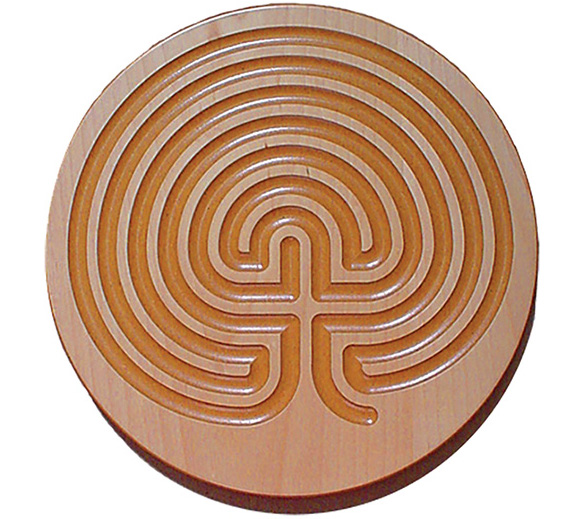
Labyrinths come in different sizes, patterns, dimensions, materials and vary while keeping their basic geometric design. Some are the size of a board game which you move through using your index finger. Others are for walking.
Prehistoric labyrinths are believed to have served either as traps for malevolent spirits or as defined paths for ritual dances. During Medieval times the labyrinth symbolized a hard path to the God with a clearly defined center (God) and one entrance (birth). Labyrinths can be thought of as symbolic forms of pilgrimage; people can walk the path, ascending towards salvation or enlightenment. Many people could not afford to simply travel to holy sites and lands, so the use of labyrinths and prayer substituted that need. Later, the religious significance of labyrinths faded and they were used primarily for entertainment, although recently their spiritual aspect has seen a resurgence. Many newly-made labyrinths exist today, in churches and parks, to provide people with a meditative way to relieve stresses and regrets (the Labyrinth Society is a modern locator to labyrinths in North America). Finally, in a symbolic sense, labyrinths have moved into higher layers of reality, the internet with its hypertext feature being a good example (the symbol of "labyrinth" merges with the symbol of "book").
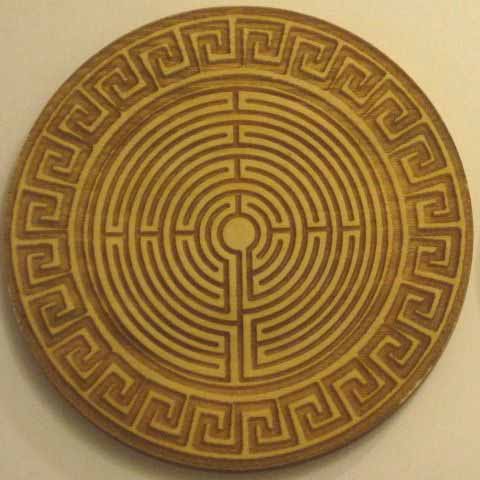
Although early Cretan coins occasionally exhibit branching (multicursal) patterns the single-path (unicursal) seven-course "Classical" design without branching or dead ends became associated with the Labyrinth on coins as early as 430 BC, and similar non-branching patterns became widely used as visual representations of the Labyrinth - even though both logic and literary descriptions make it clear that the Minotaur was trapped in a complex branching maze. Even as the designs became more elaborate, visual depictions of the mythological Labyrinth from Roman times until the Renaissance are almost invariably unicursal. Branching mazes were reintroduced only when hedge mazes became popular during the Renaissance.
In English, the term labyrinth is generally synonymous with maze. As a result of the long history of unicursal representation of the mythological Labyrinth, however, many contemporary scholars and enthusiasts observe a distinction between the two. In this specialized usage maze refers to a complex branching multicursal puzzle with choices of path and direction, while a unicursal labyrinth has only a single path to the center. A labyrinth in this sense has an unambiguous route to the center and back and presents no navigational challenge.
Unicursal labyrinths appeared as designs on pottery or basketry, as body art, and in etchings on walls of caves or churches. The Romans created many primarily decorative unicursal designs on walls and floors in tile or mosaic. Many labyrinths set in floors or on the ground are large enough that the path can be walked. Unicursal patterns have been used historically both in group ritual and for private meditation, and are increasingly found for therapeutic use in hospitals and hospices. Read more
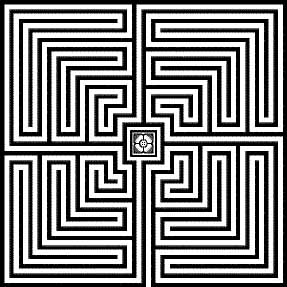
A typical Roman labyrinth design of the simple meander type
While the classical labyrinth was known throughout the Roman Empire, the popular use of the labyrinth as a design element in mosaic flooring resulted in a number of interesting developments, all conveniently classifiable as "Roman" varieties. While rarely encountered amongst the examples created during the current revival, these labyrinths are of considerable interest, as they represent the first real attempts to create different forms of the genre and the first major changes to a symbol that had already been in circulation for nearly two thousand years. Several researchers have attempted further classification of Roman designs, based on mathematical or geometrical properties, which allow the majority of the sixty or so Roman mosaic labyrinths to be designated as meander, serpentine, or spiral types.
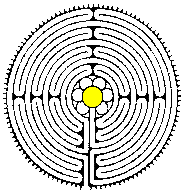
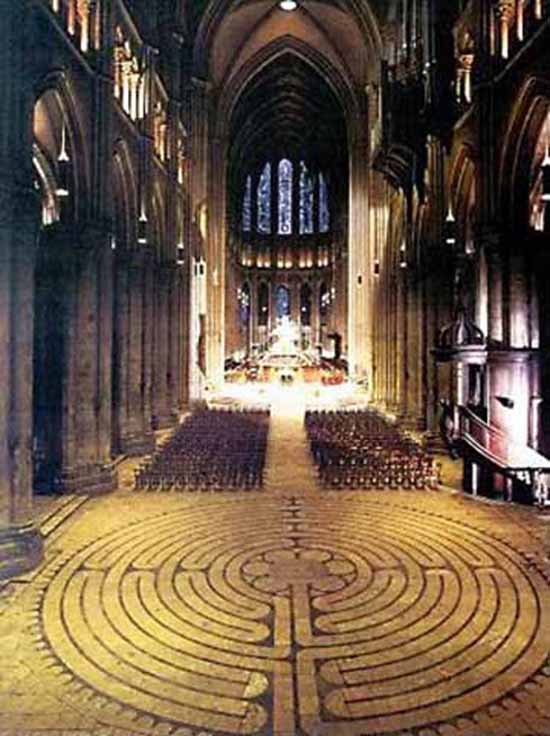
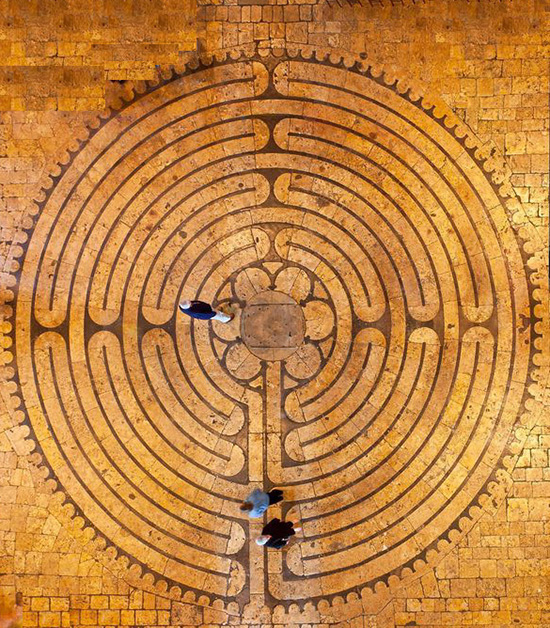
The best known example of labyrinth is embedded in the stone pavement of Chartres Cathedral near Paris. The Middle Ages was a time of pilgrimages. Since most people could not make the grand pilgrimage to Jerusalem, considered by Christians to be the center of the world, and symbolizing the Kingdom of Heaven, they would make pilgrimages to important cathedrals such as Canterbury, Santiago de Compostella and Chartres. Once there, they would end their pilgrimage by walking the labyrinth to the center, and then slowly retracing their steps to regain the 'outside world' and return to their homes. The Chartres was labyrinth sometimes walked in place of the actual pilgrimage to Jerusalem and considered a holy experience. People believed that if you walked the labyrinth with the full dedication of a pilgrim, you would be transformed, the old you will be grounded at the threshold stone a purified you emerging, ready to tackle new directions in your life's journey.
The new Cathedral labyrinth patterns were all laid out according to the same basic pattern twelve rings that enclose a meandering path which slowly leads to a center rosette. The path makes 28 loops, seven on left side toward the center, then seven on the right side toward the center, followed by seven on the left side toward the outside, and finally seven on the right side toward the outside terminating in a short strait path to the rosette.
Like all cathedral labyrinths, it draws upon the ancient northern Celtic, middle eastern, and Classical Greek and Roman origins of the Christian faith. The Medieval builders were careful to incorporate their understanding of sacred architecture into the design and location of the labyrinths, which were usually placed near the entrance at the west end of the nave, beside the baptismal font at the foot of the Church. This location symbolizes our first steps on the spiritual journey.
The labyrinth of Chartres has been referred to by four different names:
Le dedale - or Daedalus: the legendary architect who built a labyrinth for King Minos of Crete. Just as Theseus struggled against the Minotaur, so man struggles against evil, and is guided back out through the maze by Ariadne or divine grace. The labyrinth of Chartres, however, is not a complex maze but a single path with no hidden corners or dead-ends.
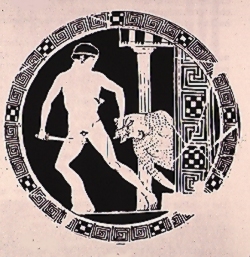
La lieue - league: which is a distance of about three miles. Although the length of the path is only 260 meters, in the Middle Ages some pilgrims would walk the labyrinth on their knees. This exercise would take about an hour, or the time needed to walk three miles.
Le chemin de Jerusalem - The Road to Jerusalem: By walking the labyrinth, the faithful could make a substitute pilgrimage to the Holy Land, and be united in spirit with the Crusaders. To make a pilgrimage to a sacred place such as the Holy City is part of an ancient and ongoing tradition of spiritual commitment. When long distance traveling became too dangerous during the upheavals of the Middle Ages, the cathedral labyrinths were installed and established as alternative destinations for pilgrimage. Pilgrimage is both a communal event and a private act of transformation. Walking the labyrinth with others reminds us that we are all on the path together, each in our own unique way.
Le chemin du paradis - Road to Paradise - the heavenly Jerusalem: By walking the labyrinth, the faithful trace the path of our long and laborious life on earth, beginning with birth, at the entrance, and ending with death, at the center. The way out symbolizes purgatory and resurrection.
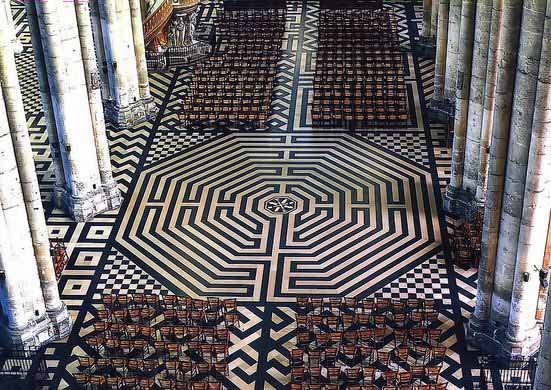
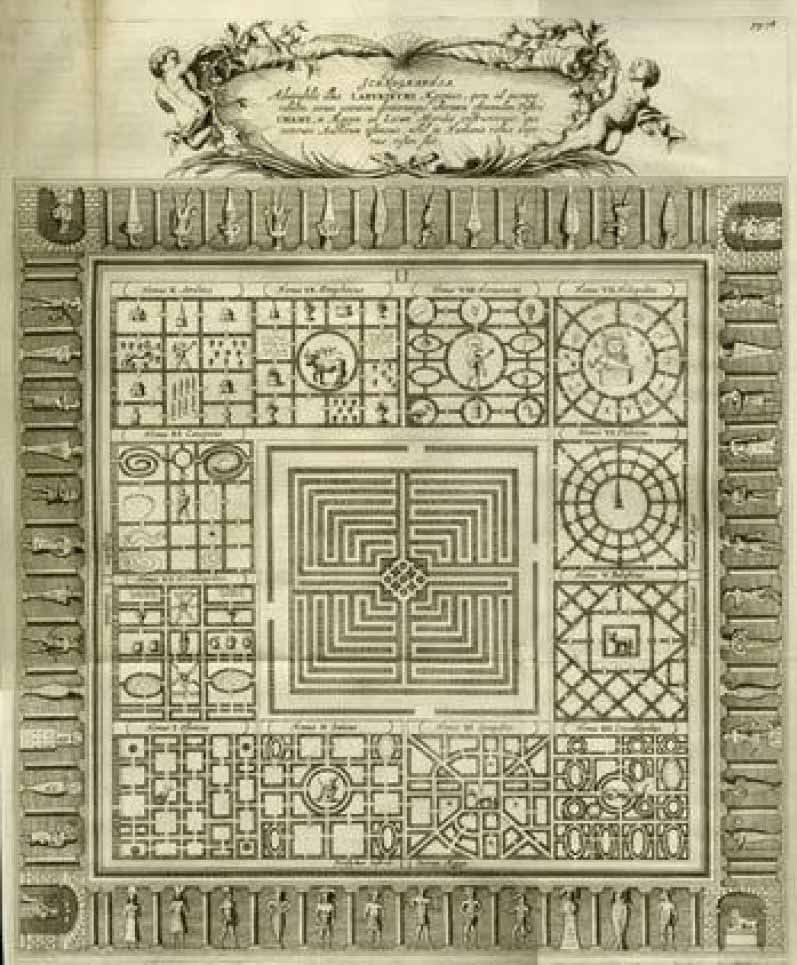
Pliny's Natural History mentions four ancient labyrinths: the Cretan labyrinth, an "Egyptian labyrinth", a "Lemnian labyrinth" and an "Italian labyrinth".
Pliny's "Egyptian labyrinth" -- Even more generally, "labyrinth" might be applied to any extremely complicated maze-like structure. Herodotus, in Book II of his Histories, describes as a "labyrinth" a building complex in Egypt, "near the place called the City of Crocodiles," that he considered to surpass the pyramids in its astonishing ambition:
Pliny's "Lemnian labyrinth - "Pliny's Natural History (36.90) lists the legendary Smilis, reputed to be a contemporary of Daedalus, together with the historical mid sixth-century BCE architects and sculptors Rhoikos and Theodoros as one of the makers of the "Lemnian labyrinth", which Andrew Stewart (One Hundred Greek Sculptors: Their Careers and Extant Works, "Smilis") regards as "evidently a misunderstanding of the Samian temple's location en limnais, 'in the marsh'".
Pliny's "Italian labyrinth" - According to Pliny, the tomb of the great Etruscan general Lars Porsena contained an underground maze. Pliny's description of the exposed portion of the tomb is intractable; Pliny, it seems clear, had not observed this structure himself, but is quoting the historian and Roman antiquarian Varro.
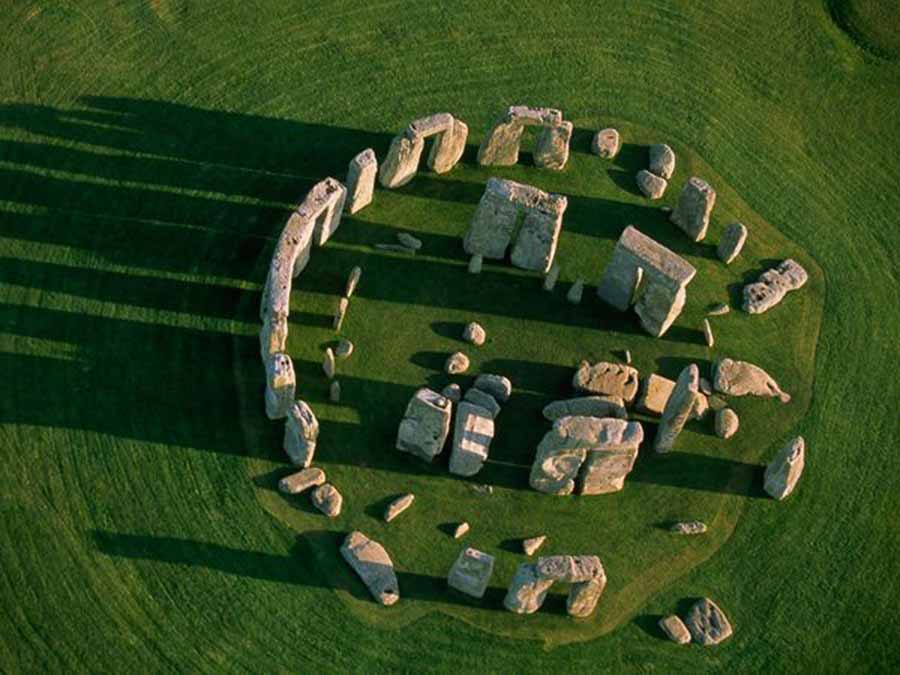
England contains many unicursal turf mazes, some possibly dating back to the Dark Ages, when they were created by the nordic settlers. One distinctive aspect of British mazes is their diversity, with possibly the widest range of forms of maze of any country in the world. Hedge mazes are particularly distinctive to Britain, whilst mazes using turf, brick, stone, wood and water are also widespread. Indoors, there are mazes made of mosiac, marble and stained-glass, as well as mirror mazes.
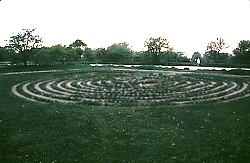
Sweden Galgeberget, Visby, Gotland
Scandinavian labyrinths, generally in coastal areas, are marked out with stones most often in the simple classical form. They often have names which translate as "Troy Town". They are thought to have been constructed by early fishing communities, to trap malevolent trolls/winds in the labyrinth's coils in order to ensure a safe fishing expedition. There are also stone labyrinths on the Isles of Scilly, although none of them is known to date back as far as the Scandinavian ones.
There are remarkable examples of the labyrinth shape from a whole range of ancient and disparate cultures. The symbol has appeared in all its forms and media (petroglyphs, classic-form, medieval-form, pavement, turf and basketry) at some time, throughout most parts of the world, from Java, Native North and South America, Australia, India and Nepal.
In Scandinavia hundreds of stone labyrinths line the shores of the Baltic Sea, with over half of them in Sweden. Many are said to have been built by fishermen, who walked through them in the hope of a good catch and a safe return. Their varied names - Julianis Bower, Maiden's Bower, Trojaborg - give further insight to their purpose, as an expression of the pursuit of maidens, courtship, the act of fertility, penetration of the womb, the creation of the embryo with its umbilical cord, and the birth of new life.
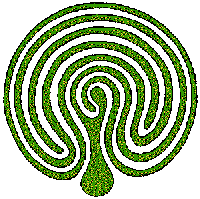
Baltic Wheel
More than in other countries, Switzerland seems to embrace the appropriateness of labyrinths in public places, of which more than 50 have been established in recent years, in addition to dozens of other on private property. The impetus for public labyrinths began when artist Agnes Barmettler and art teacher Rosmarie Schmid won first place among 140 entrants in a 1989 design competition for public spaces, sponsored in Zurich for the 700th anniversary of the founding of the Swiss Federation. The project was constructed on the site of a former military academy (Zeughausareal), just a ten minute walk from the central train station. Some 30 meters (98 feet) in diameter, the labyrinth is of contemporary design including landscaping that is maintained by a corps of women volunteers.
Besides the Chartres and Cretan patterns, another commonly used design is the Scandinavian or Baltic Wheel, which allows a choice between a longer path or a shorter one, an especially useful feature in very large labyrinths.
The women creators of Switzerland's labyrinths have emphasized harmony with the natural surroundings, including trees, rocks and brooks in the designs. Case in point, the labyrinth at the Academy of Boldern, Mannedorf (on Lake Zurich), placed in front of a Japanese pavilion, has the feel of a Zen garden. This is the largest labyrinth in Switzerland and follows the pattern of the Baltic Wheel pattern in Hanover, Germany.
In Germany, unicursal turf mazes were used for ritual procession by apprentices as they reached adulthood. Most German labyrinths are the result of women's groups, inspired and assisted by the labyrinth community from Switzerland. Schmid and Barmettler have made more than 50 presentations to Volkshochschulen (institutions for permanent education) , Frauenzentren (women's centers), and other groups in Germany. As in Switzerland, there is a strong bent toward geomantic considerations in the design and placement of the labyrinths.
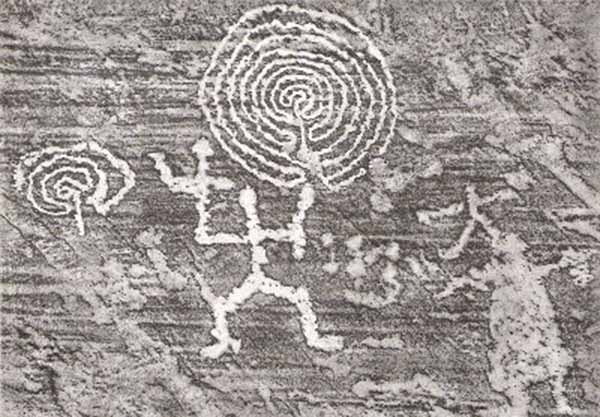
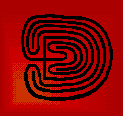
Hopi Round Labyrinth
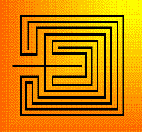
Hopi Square Labyrinth
The Symbol of the Emergence - The whole myth and meaning of the Emergence is expressed by one symbol known to the Hopis as the Mother Earth symbol. There are two forms, the square [yellow above] and the circular [red above]. Examples of these Labyrinth are carved on a rock south of Oraibi, and south of Shipaulovi. A combination of the two forms is also carved on a wooden stick which is planted in front of the One Horn altar in the Kwani kiva at Walpi during the Wśwuchim ceremony. The symbol is commonly known as Tapu'at [Mother and Child]. This type represents spiritual rebirth from one world to the succeeding one, as symbolized by the Emergence itself.
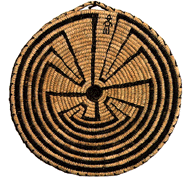
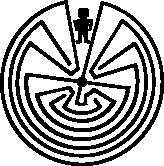
The Man in the Maze
At one level, the labyrinth symbolizes the female womb, only penetrable if one is pure and perfect. The male figure outside, representing the human seed, can penetrate the womb, fertilize the ovum, produce new life, which then emerges as a new birth or a reincarnated existence. Entry into the labyrinth gives new life to litoi, thus achieving reincarnation and eternal life.
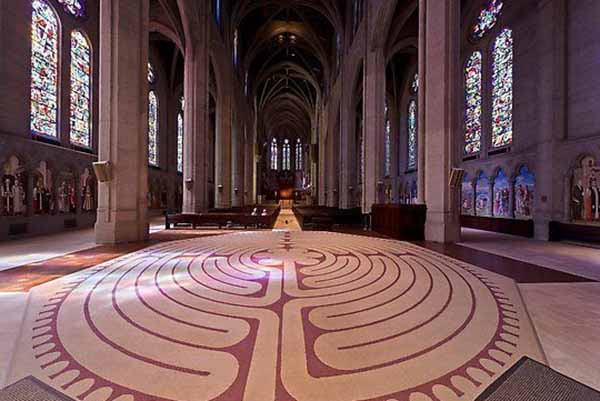

The spread of European colonization to these region from the late 18th century onwards brought the labyrinth, in one or other of its forms. Many of the original labyrinths were later destroyed.
The first labyrinth in Australia appears to be the Ballarat hedge maze, in the Botanical Gardens, originally planted in 1862, cleared in 1881, replanted in the late 1880's and eventually destroyed in 1954. Most are direct copies of hedge mazes in Britain.
The first maze in New Zealand was in 1911 at the Dunedin Botanic Garden, a hedge maze, but was removed. In recent years the concept of the labyrinth has once again become popular in Australia and New Zealand.

You've heard of sand paintings and sculptures and crop circles (landscape art). How about therapeutic sand labyrinths?
Denny Dyke, 72, has always considered himself a spiritual person. But until a few years ago, he wasn't very artistic. He had moved up to Oregon from Southern California and had spent some time practicing walking meditations on the beach. He would draw in the sand as he walked, sometimes creating intricate designs. "They were mainly for myself, but a few people would show up. Dyke felt the pull of the ever-changing landscape of the waves and the sand.
He started to design complex, yet temporary, labyrinths that would soon be washed away by the tides. "I decided if people were responding - and the response was pretty phenomenal - then I would keep doing it," he says. Dyke typically draws from May through September. The process takes about two hours with Dyke's team, including sand artist Christine Moehring. The only thing that stops him is rain or snow. Each labyrinth is original and is about a quarter-mile to a half-mile to walk all the way through. In 2018 he drew the largest and longest: a two-acre labyrinth. Read more ...
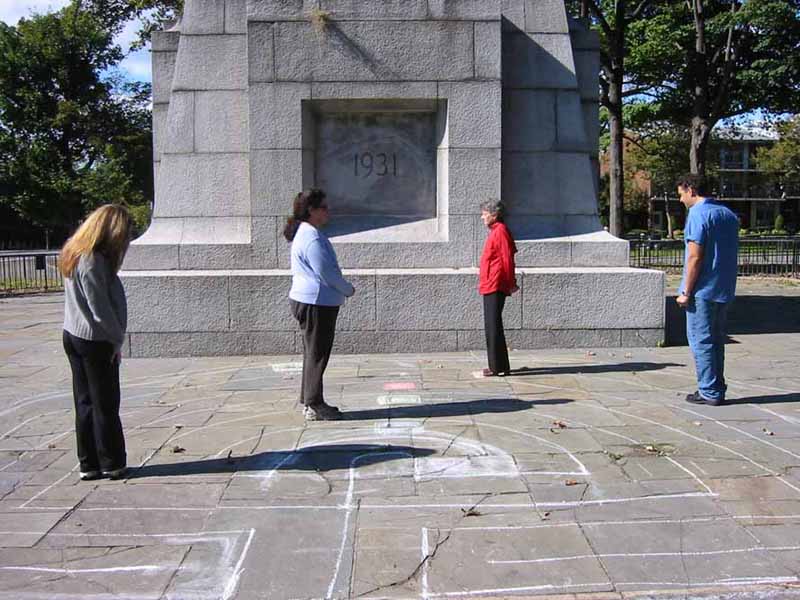

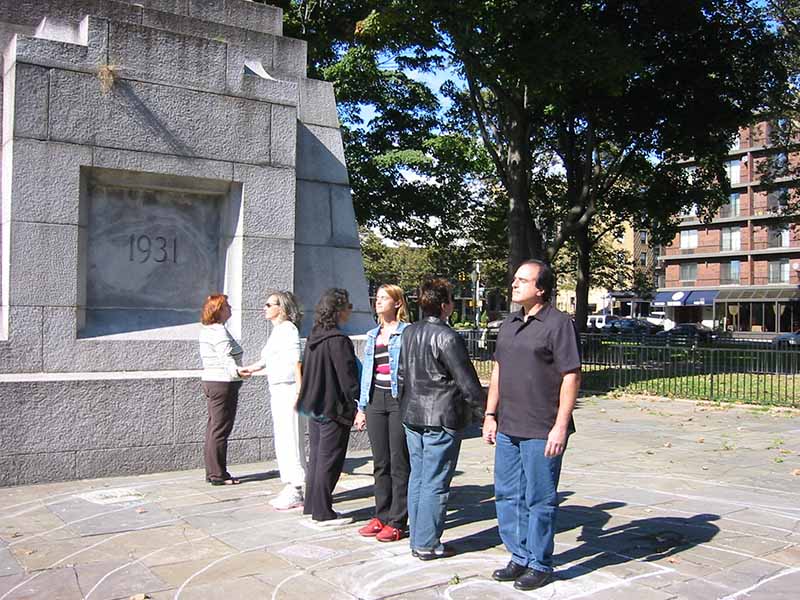

Garden Labyrinths can be aligned with earth energies, ley lines and grid points. Dowsing rods can be used.
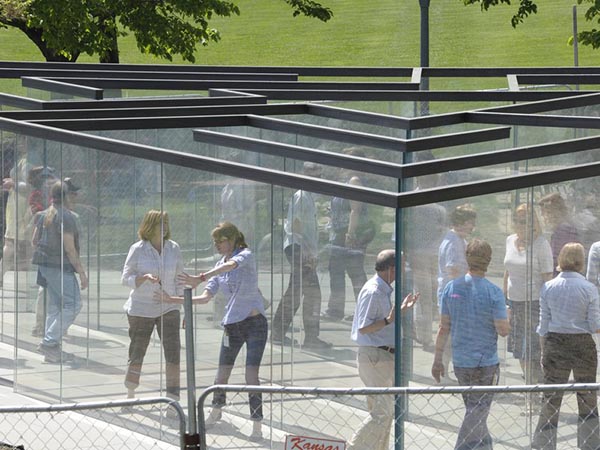
Visit a Glass Labyrinth in Kansas City Smithsonian - June 5, 2014
The Glass Labyrinth, a sculpture by minimalist artist Robert Morris, is now open to the public at the Nelson-Atkins Museum in Kansas City, Mo. Nearly one million pounds of one-inch-thick plate glass went into the sculpture, which was built to commemorate the 25th anniversary of the Donald J. Hall Sculpture Park.
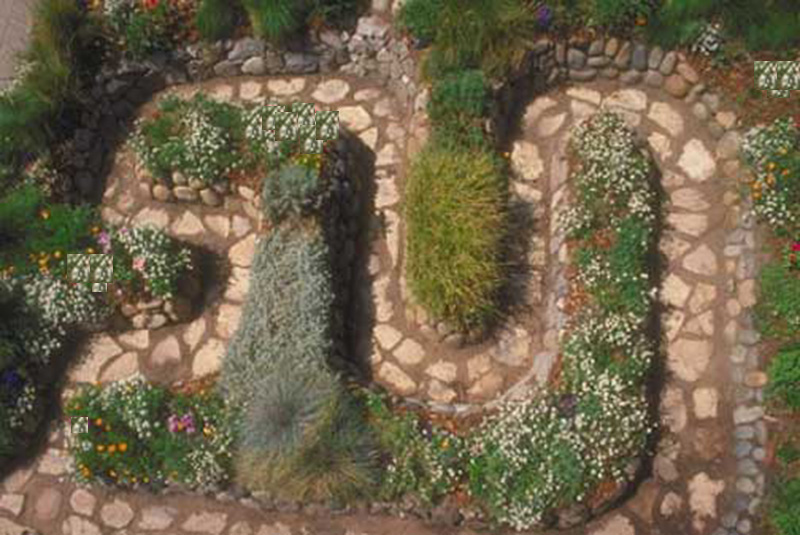
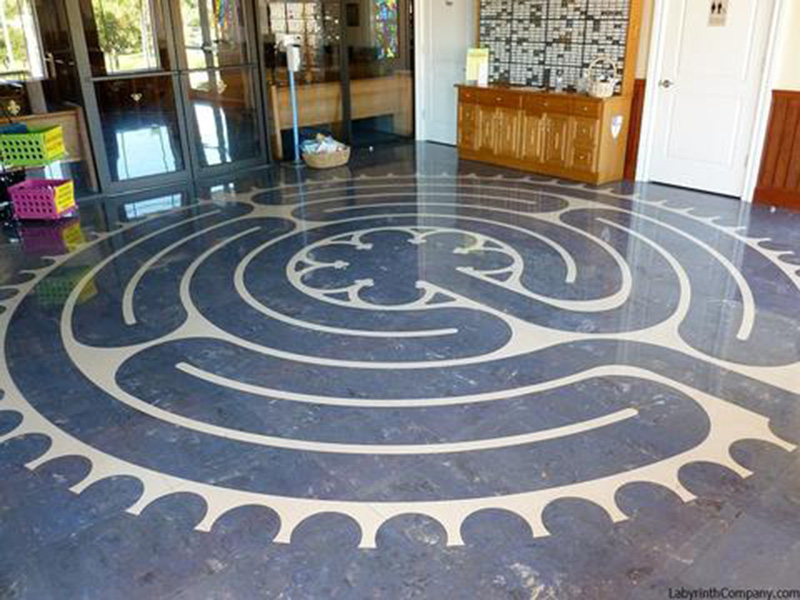
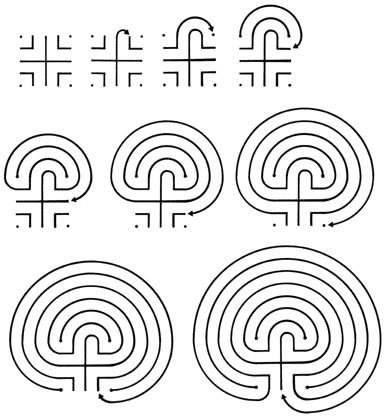
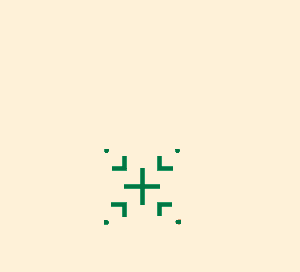
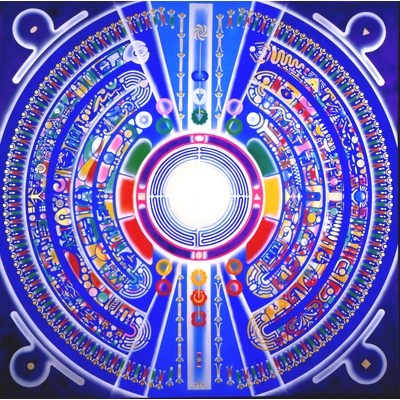
Labrys -13, a Star Wheel Labyrinth
The center of Labrys -13 shows a 13-ring labyrinth:
follow the traced lines - and jump over the arms of the cross.
Labyrinths are linked to Mandalas - sanskrit for 'circle that contain the Essence'. Like mandalas, labyrinths are archetypal collective symbols that transcend all cultures because they are grounded in consciousness itself. On the left & right of the center, some meanders have been expanded to fill the entire mandala: they show the stories and adventures one encounters by meandering through life. Shown as a bottom-top axis containing the progression of the chakra symbols, there is a column Light that should actually be seen in 3D as going through the center. A mandala looks like a 2-D cross-section but is in fact a 3-D sphere. On the periphery, many apprentice pilgrims are forming a queue. Eventually, when they reach the north position portal, they will be able to descend (incarnate) into their life's journeys. The name 'labrys' comes from the shape of the openings, in the north and south positions, that resemble the antique labrys, a ceremonial double ax & magical scepter of the Amazons.
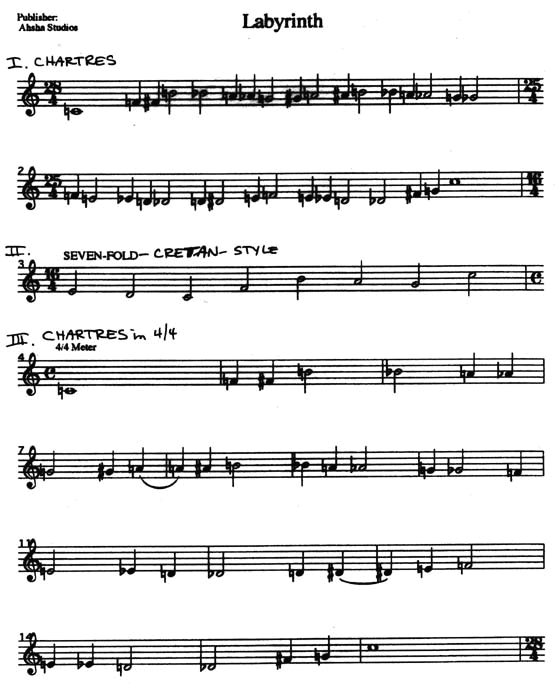
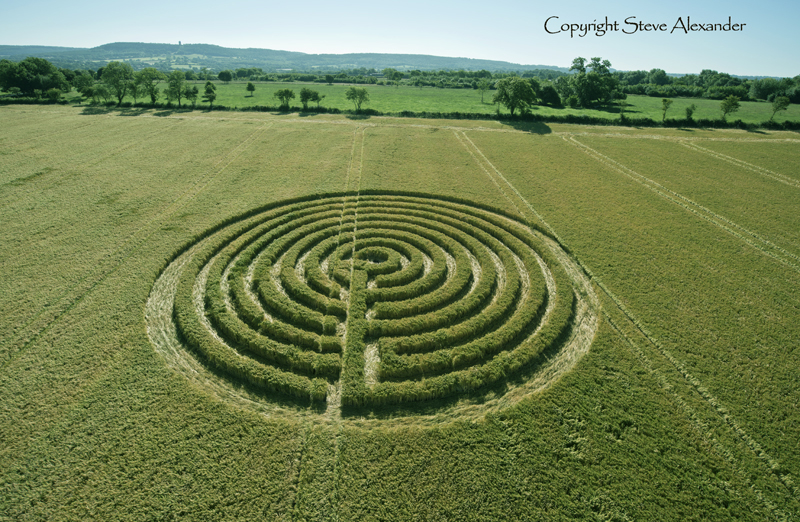
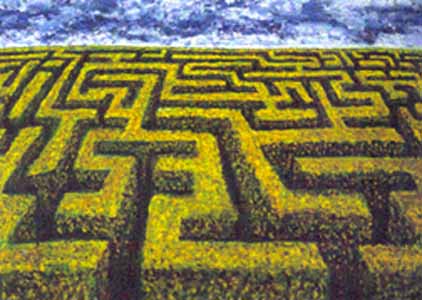
MAZES